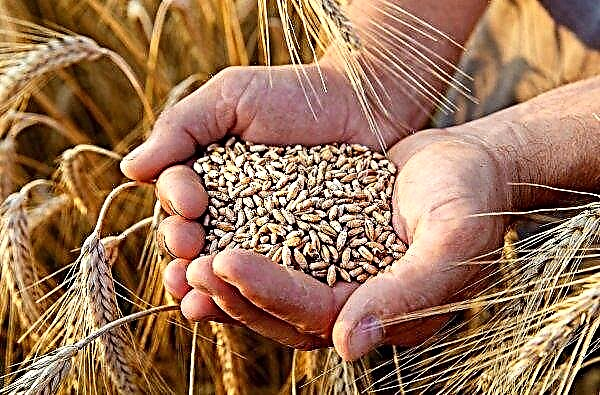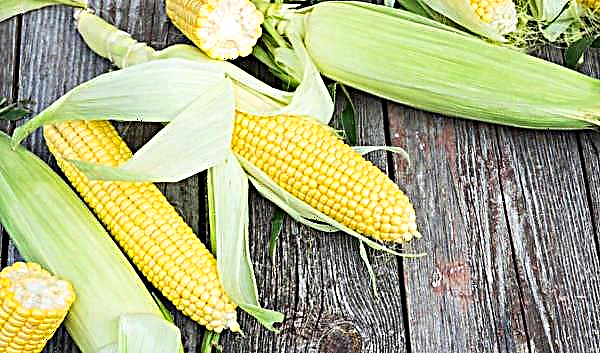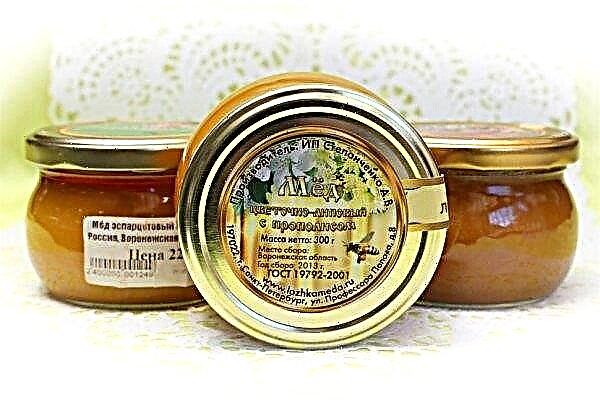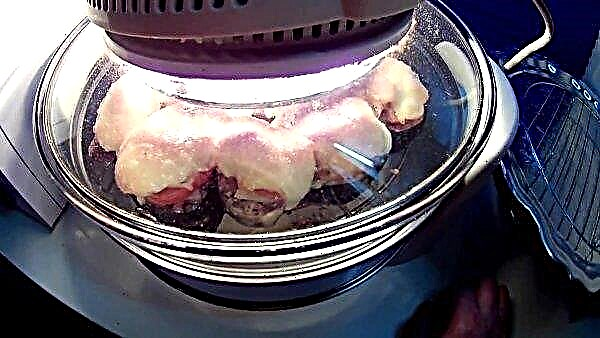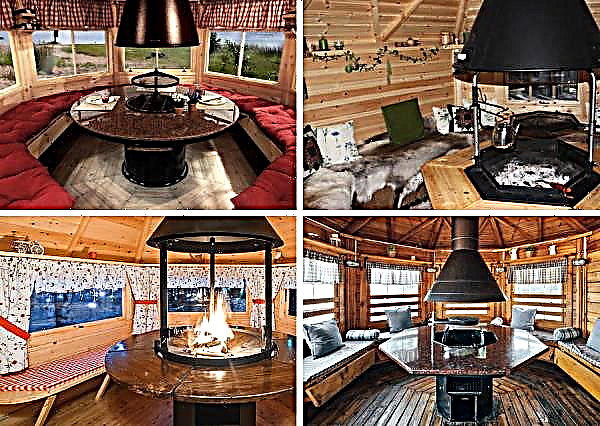The cultivation of meat-and-egg chickens is widely practiced among farmers. One of these breeds is Amrox. They have excellent egg production and good meat performance. Growing Amrox can be a profitable investment.
History reference
Amroxes are the result of deliberate selection of striped Plymouth Rock. The date of breed breeding is considered to be 1848 (Germany). German breeders took American meat-and-egg Plymouthrocks as a basis and strengthened their egg-bearing qualities.
In addition, the breed is considered an excellent genetic material for the further work of breeders to improve the breeds of meat and egg orientation.Did you know? People began to raise chickens for meat and eggs far from immediately. 5000 years ago, a man accustomed wild banking Chickens because of their fighting properties.

General characteristics
The appearance of the Amroxes is attractive. Powerful birds in striped vests look just great. The middle erect scallop of the rooster and the red catkins give it a formal appearance.
The breed is distinguished by:
- precocity - from 5 months;
- good disease resistance;
- high egg production - about 200 eggs per year;
- resistance to different climatic conditions.
Appearance
| Amrox Exterior | the bird is quite tall, powerful, proportionately folded |
| Head | large, proportional to the body |
| Crest | medium, erect, bright red in color with pronounced 6 teeth |
| Beak | powerful yellow |
| Neck | powerful, medium-sized collar |
| Chest | wide, strong |
| Stomach | volume |
| Wings | short, well-feathered |
| Tail | short, lush, with medium braids |
| Paws | powerful |
| Plumage and color | plumage - dense, black-and-white cuckoo color from alternating stripes; hens are brighter than males |

Temperament
Amroxes are energetic, but quietly get along with other birds. They are comfortable with both closed and open range.
Important! Hens do not rush in the dark. Even a fully formed egg will not blow a chicken if it considers the conditions for egg laying inappropriate.
Advantages and disadvantages
- pros
- high productivity indicators;
- excellent taste of meat and eggs;
- lack of requirements for special content;
- good adaptability to conditions of detention;
- precocity
- high survival of offspring (almost approaching 100%).

- Minuses
- the predominance of broods of males;
- the probability of early egg production - earlier than 5 months with a predominance of small, up to 35 g of testicles;
- some farmers consider Amrox bad hens.
Maintenance and care
Amroxes are undemanding to content, so they are recommended for beginners.
The basic requirements for keeping them are the same as for most breeds:
- dry litter in the chicken coop and nests;
- maintaining cleanliness in the chicken coop and on the walk;
- the presence of a balanced feed;
- regular feeding.

Chicken coop requirements
Amroxam is suitable for a standard chicken coop with a height of at least 2 m. It is not necessary to heat it specially, it is enough that it is insulated and there are no drafts. The house should be located away from noise sources since noise reduces egg production and disturbs birds.
Sizes of a chicken coop:
- chicken coop height - not lower than 2 m;
- area per 1 bird - at least 0.33 sq. m per 1 individual;
- length and width of the chicken coop - calculated on the basis of the number of chickens on the farm;
- perch height - 1 m;
- perch width - not less than 40 cm.
Mandatory presence of windows for access of light. Illumination affects egg production, therefore in winter there should be additional lighting in the chicken coop with an extension of daylight hours up to 10-12 hours. Ventilation can be forced-air and exhaust and organized using 2 pipes. To regulate the air flow, the pipes can be equipped with dampers.
Patio for walks
Activity is important, first of all, for gaining weight. Therefore, chickens that are not in free grazing should have a walking yard. The soil is necessarily covered with grass. If the courtyard is mobile, then it is necessary to move it as the grass pecks. Fencing - mesh. Amroxes are flightless chickens, so a height of 1.5 m will be enough. Area for 1 individual - at least 1 sq.m.
Feeding troughs and drinking bowls
The internal equipment of the chicken coop includes:
- feeding troughs;
- drinkers;
- perches;
- nests from the calculation - one for 3 hens.
On the floor there should be a dry litter about 5 cm thick. The nests should also have dry litter. To combat skin parasites, an ash bath is installed on the floor. Drinking bowls of any type can be used, the main thing is that they are at the height of the chicken’s head and out of reach of its paws. A nipple drinker is very convenient in that it does not create excess moisture. Feeders are made of any non-moisture material: plastic, polypropylene, etc. They are installed on the wall of the house.
A nipple drinker is very convenient in that it does not create excess moisture. Feeders are made of any non-moisture material: plastic, polypropylene, etc. They are installed on the wall of the house.
Did you know? Hens have been accompanying humans for over 5,000 years. During this time, more than 16 countries immortalized them on their coins. Representatives of chickens were depicted on the arms of many cities, and in the countries of the East they received divine honors.
Shedding and egg laying break
Moult begins in the fall. This is due to the preparation of plumage for a different temperature regime. May last from 1 week or more. To speed up the process, it is recommended to reduce daylight hours and give enhanced nutrition. The better the nutrition is balanced, the faster the physiological molting will end.
How to feed an adult herd
The ration is based on a combination of dry, wet and combination feeds. Preferred cereals are corn, wheat and barley. Wet mixers are prepared from crushed grain with the addition of oilcake, meat and bone meal. Prepare a mash in broth or back. Hookahs are especially useful in winter in the absence of vitamins. Compound feed can be industrial or prepared independently from dry grain with the addition of vitamin complexes, bran and other components. Root crops and greens must also be present in the diet.
Compound feed can be industrial or prepared independently from dry grain with the addition of vitamin complexes, bran and other components. Root crops and greens must also be present in the diet.
Breeding chickens
To breed Amroxes, you can buy eggs and incubate them, buy chickens of this breed from breeders or adult hens with a cockerel. It is very convenient to buy Amrox chickens because of their characteristic dark color. At a weekly age, babies have stripes. Chickens are characterized by rapid growth and flexibility.
Important! To preserve pedigree traits, chickens need a rooster that does not belong to their brood. By age, the cock should be a year older than his girlfriend.
Egg incubation
For incubation, clean eggs are selected without external defects. Hatching eggs must not be washed so as not to infect them with bacteria. The same size of eggs provides simultaneous hatching of masonry. The date of demolition should be no more than 10 days from the date of incubation. Before laying eggs, they are checked with an ovoscope for the correct location of the camera and the absence of shell defects. The incubation period is 19-21 days. If a laying egg incubates, then it will take care of the correct temperature and humidity on its own. For an incubator - it is necessary to precisely follow the instructions for the incubation process. When viewed with an ovoscope, you can see the germinal disc. On the first day of development, blood vessels begin to grow from it.
The incubation period is 19-21 days. If a laying egg incubates, then it will take care of the correct temperature and humidity on its own. For an incubator - it is necessary to precisely follow the instructions for the incubation process. When viewed with an ovoscope, you can see the germinal disc. On the first day of development, blood vessels begin to grow from it.
On the second day, a special bag with embryonic fluid is formed. At the same time, the formation of future organs takes place and you can hear the heartbeat of the embryo. On the third day, the chicken has a head. In the next few weeks, the embryo grows and improves.
The chick will be fully formed on 20-21 days. At this time, it will weigh about 35 g, and its size will be 8 cm. The chicken independently breaks the shell and gets out of the egg.
Baby Care
Daily chickens are fed a boiled egg and millet porridge. They are drunk with a decoction of medicinal chamomile. During the first week, chopped beet tops, boiled carrots, cottage cheese and yogurt are introduced into the diet. The chickens are fed 8 times a day, and then over the course of three months the number of feeds is gradually reduced, bringing them to the schedule of feeding adult hens. During the growth period, proper nutrition is important, so farmers introduce mixed feeds into the diet:
During the growth period, proper nutrition is important, so farmers introduce mixed feeds into the diet:
- Start - for chickens;
- Fattening - for young animals from 1 month to 3;
- The finish - for adult chickens.
Also important:Did you know? Chickens, like humans, have an obesity problem. If you overfeed the birds, they will become larger, but will be carried less frequently. Therefore, the egg production of Amroxes is different in different sources, and ranges from 180 to 220 eggs.
- regular cleaning;
- control of air temperature and lighting;
- regular cleaning and washing of feeders.

Feeding rules
The diet of young animals should contain 70% of cereals and 30% of wet mixes. Young growth feeds in much the same way as adult chickens - a standard diet with vitamin supplements.
Amrox diet (in grams):
- grain feed - 110-120, of which: corn - 40, wheat, barley and oats 25-30 g in equal proportions;
- root crops and greens - 100;
- wet mixers - 30–40.
In the mixers add meat and bone meal, salt, bran. For laying hens during the laying period, chalk, shellfish, cottage cheese, and reverse are needed. The body actively consumes calcium reserves. Appearance, high productive qualities, good adaptability to climate make Amroks good candidates for keeping in order to get a large number of eggs and meat.Did you know? In the world there are about 700 breeds of chickens with a total number of more than 19 billion. This is three times more than people.
 And their calm temperament will not cause trouble when living with other birds in the same compound. Therefore, they can contain both large farms and private small households.
And their calm temperament will not cause trouble when living with other birds in the same compound. Therefore, they can contain both large farms and private small households.



